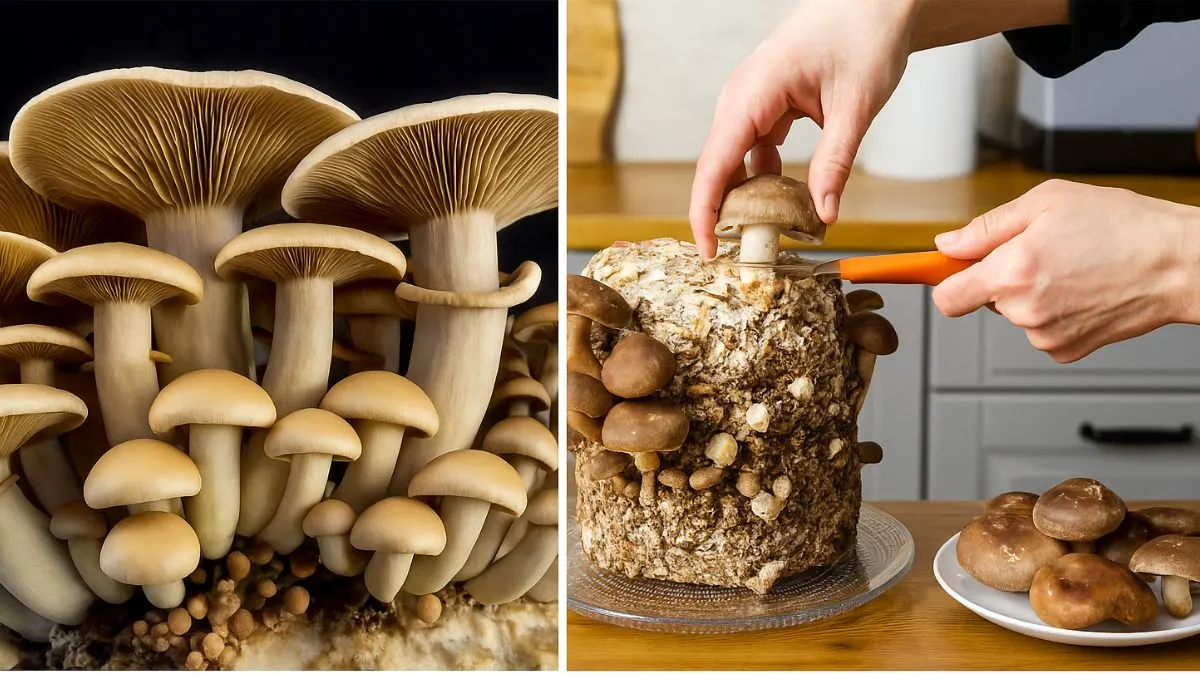Unlike regular plants, mushrooms aren’t grown from seeds but from spores. They don’t need sunlight, and they thrive in darker, humid spaces—making them ideal for indoor cultivation. For beginners, planting them indoors is a fascinating experience because it combines gardening with science. With just a small space and a few supplies, you can enjoy a continuous supply of earthy, fresh mushrooms in your kitchen.
This introduction to fungi cultivation will walk you through every step, making it easy for first-time growers.
Step 1: Choosing Your Mushroom Variety

The first step is choosing your mushroom variety. For beginners, oyster mushrooms, white button mushrooms, and shiitake mushrooms are the easiest to start with.
- Oyster mushrooms grow quickly and are very forgiving, making them perfect for first-time gardeners.
- White button mushrooms are mild in flavor and widely used in North America and Europe.
- Shiitake mushrooms take a little longer but reward you with a deep, smoky taste.
When I first started them growing, I went with oyster mushrooms because they grew rapidly, and I could see results in just a few weeks. That instant success boosted my confidence to experiment with other varieties.
Step 2: Preparing the Growing Medium
Unlike vegetables, mushrooms don’t grow in soil. Instead, they need a substrate that provides nutrients. The most common substrates are:
- Compost (rich and nutrient-dense, great for button mushrooms)
- Straw
- Sawdust
- Coffee grounds (excellent for recycling kitchen waste)
If you’re a beginner, compost mixed with straw is often the easiest and most reliable option.
Also Read: Amla Fruit: The Superfood Your Body Has Been Missing
Step 3: Setting Up the Right Environment
Mushrooms thrive in cool, dark, and humid environments. Basements, garages, or closets work well.
- Temperature: Most varieties prefer between 55°F to 70°F (13°C to 21°C).
- Humidity: Keep humidity high by misting regularly or using a humidity tent.
- Light: Mushrooms don’t require sunlight; in fact, too much light can hinder growth.
Think of the setup as recreating a small forest floor indoors.
Step 4: Planting the Mushroom Spawn
Instead of seeds, they are grown from spawn (similar to seedlings for plants).
- Spread your mushroom spawn evenly into the prepared substrate (like compost).
- Keep the mixture moist but not soggy.
- Cover the container with a damp cloth or plastic wrap to retain humidity.
Over the next couple of weeks, you’ll notice thin, white thread-like structures spreading across the substrate. This is called mycelium, the vegetative part of the fungus, and it’s a sign that they are growing.
Step 5: Caring for Your Mushrooms
Caring for mushrooms is surprisingly simple.
- Mist the surface daily to maintain moisture.
- Ensure good ventilation to prevent mold.
- Keep temperatures stable within the recommended range.
This stage is where most beginners succeed, because once the mycelium is well established, they almost grow on autopilot.
Also Read: These 3 Houseplants Practically Grow Overnight
Step 6: Harvesting
Depending on the variety, they are ready in 3 to 6 weeks.
- For button mushrooms, harvest when caps are closed.
- For oyster mushrooms, harvest when the edges of the caps flatten out.
- For shiitake mushrooms, pick when the caps are 70% open.
Use a sharp knife or twist gently to avoid damaging the substrate, allowing for multiple flushes (harvests) from the same setup.
Common Mistakes to Avoid
Mistake |
Why It Happens |
How to Fix It |
Overwatering |
Too much misting |
Keep surface moist, not soggy |
Poor air circulation |
Growing in sealed containers |
Use breathable covers or ventilation |
Wrong substrate |
Using plain soil |
Always use straw, sawdust, or compost |
Why Mushrooms Are Perfect for Indoor Gardening
- They don’t need sunlight, making them perfect for small apartments.
- They use waste materials like coffee grounds, contributing to sustainability.
- With a little compost and a simple setup, anyone can enjoy fresh them year-round.
When I grew my first batch in Canada, I was amazed at how quickly they appeared. One day there was nothing, and the next morning, small caps were pushing through the substrate. It felt magical—like watching nature’s hidden cycle unfold right in my living room.
Also Read: Yarrow: Nature’s Hidden Healing Herb
With consistent care and patience, you’ll be harvesting fresh, flavorful mushrooms in just weeks. Whether you’re in the USA, Canada, or anywhere else in the world, this simple method allows you to enjoy homegrown mushrooms year-round.
So why wait? Get started today, and discover the joy of mushroom gardening inside your own home.






